Related Research Articles

Nazi Germany used six extermination camps, also called death camps, or killing centers, in Central Europe during World War II to systematically murder over 2.7 million people – mostly Jews – in the Holocaust. The victims of death camps were primarily murdered by gassing, either in permanent installations constructed for this specific purpose, or by means of gas vans. The six extermination camps were Chełmno, Belzec, Sobibor, Treblinka, Majdanek and Auschwitz-Birkenau. Extermination through labour was also used at the Auschwitz and Majdanek death camps. Millions were also murdered in concentration camps, in the Aktion T4, or directly on site.
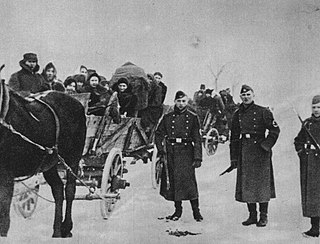
Belzec was a Nazi German extermination camp in occupied Poland. It was built by the SS for the purpose of implementing the secretive Operation Reinhard, the plan to murder all Polish Jews, a major part of the "Final Solution" which in total entailed the murder of about six million Jews in the Holocaust. The camp operated from 17 March 1942 to the end of June 1943. It was situated about 500 m (1,600 ft) south of the local railroad station of Bełżec, in the new Lublin District of the General Government territory of German-occupied Poland. The burning of exhumed corpses on five open-air grids and bone crushing continued until March 1943.
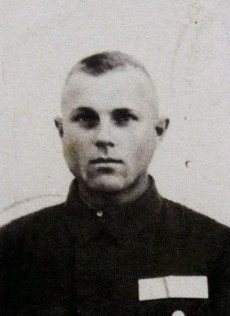
John Demjanjuk was a Ukrainian-American who served as a Trawniki man and Nazi camp guard at Sobibor extermination camp, Majdanek, and Flossenbürg. Demjanjuk became the center of global media attention in the 1980s, when he was tried and convicted in Israel after being misidentified as "Ivan the Terrible", a notoriously cruel watchman at Treblinka extermination camp. In 1993 the verdict was overturned. Shortly before his death, he was tried and convicted in the Federal Republic of Germany as an accessory to the 28,060 murders that occurred during his service at Sobibor.

Sobibor was an extermination camp built and operated by Nazi Germany as part of Operation Reinhard. It was located in the forest near the village of Żłobek Duży in the General Government region of German-occupied Poland.

Gustav Franz Wagner was an Austrian member of the SS with the rank of Staff sergeant (Oberscharführer). Wagner was a deputy commander of Sobibor extermination camp in German-occupied Poland, where 200,000-250,000 Jews were murdered in the camp's gas chambers during Operation Reinhard. Due to his brutality, he was known as "The Beast" and "Wolf".
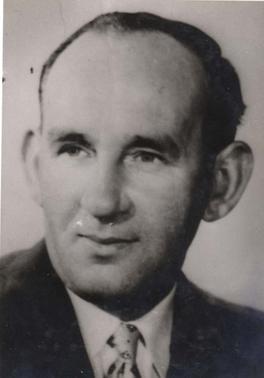
Karl August Wilhelm Frenzel was an SS noncommissioned officer in Sobibor extermination camp.
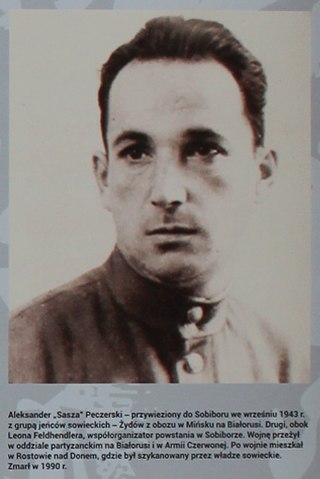
Alexander 'Sasha' Pechersky was one of the organizers, and the leader, of the most successful uprising and mass-escape of Jews from a Nazi extermination camp during World War II, which occurred at the Sobibor extermination camp on 14 October 1943.

Heinrich Barbl was an Austrian-born SS-Rottenführer. He participated in the T-4 euthanasia program in Nazi Germany and, after the invasion of Poland, in Operation Reinhard phase of the Holocaust.

Erich Gustav Willie Lachmann was an SS functionary who participated in Operation Reinhard in Sobibor extermination camp. Lachmann was born on 6 November 1909 in Legnica. His first job was that of a journeyman bricklayer. In spring 1933, he joined the Stahlhelm paramilitary organization and subsequently the SA, despite not being a member of the Nazi Party. In September of that same year, he was conscripted into the auxiliary police force and attended an Unterführer training course in Katowice. Despite failing the course, he was promoted to Oberwachtmeister.
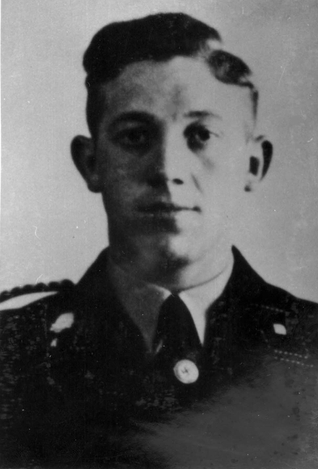
Johann Niemann was a German SS officer and Holocaust perpetrator who was deputy commandant of Sobibor extermination camp during Operation Reinhard. He also served as a Leichenverbrenner at Grafeneck, Brandenburg, and Bernburg during the Aktion T4, the SS "euthanasia" program. Niemann was killed during the Sobibor prisoner uprising in 1943.

Siegfried Graetschus was a German SS functionary at the Sobibor extermination camp during Operation Reinhard, the deadliest phase of the Holocaust in occupied Poland. He was assassinated by a prisoner during the Sobibor uprising.

Jules Schelvis was a Dutch Jewish historian, writer, printer, and Holocaust survivor. Schelvis was the sole survivor among the 3,005 people on the 14th transport from Westerbork to Sobibor extermination camp, having been selected to work at nearby Dorohucza labour camp. He is known for his memoirs and historical research about Sobibor, for which he earned an honorary doctorate from the University of Amsterdam, Officier in the Order of Orange-Nassau, and Order of Merit of the Republic of Poland.

Dov Freiberg born Berek Freiberg, was a Holocaust survivor, writer, and witness at the Eichmann trial and the Demjanjuk case. Freiberg was a prisoner at Sobibor extermination camp where he participated in the Sobibor prisoners' revolt. After the revolt, he managed to escape into nearby woods and survived until the Soviet Army entered in July 1944.
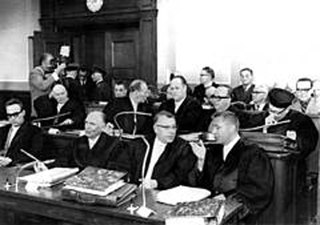
The Sobibor trial was a 1965–66 judicial trial in the West German prosecution of SS officers who had worked at Sobibor extermination camp; it was held in Hagen. It was one of a series of similar war crime trials held during the early and mid-1960s, such as the 1961 trial of Adolf Eichmann by Israel in Jerusalem, and the Frankfurt Auschwitz Trials of 1963–65, also held in West Germany. These trials heightened general public and international understanding of the extent of the crimes that had been perpetrated in occupied Poland some twenty years earlier by Nazi bureaucrats and persons acting as their executioners.
"Ivan the Terrible" is the nickname given to a notorious Ukrainian guard at the Treblinka extermination camp during the Holocaust. The moniker alluded to Ivan IV, also known as Ivan the Terrible, the infamous Tsar of Russia. "Ivan the Terrible" gained international recognition following the 1986 John Demjanjuk case. By 1944, a cruel guard named "Ivan", sharing his distinct duties and extremely violent behavior with a guard named "Nicholas", was mentioned in survivor literature. Ukrainian American John Demjanjuk was first accused of being Ivan the Terrible at the Treblinka concentration camp. Demjanjuk was found guilty of war crimes and was sentenced to death by hanging. Exculpatory material in the form of conflicting identifications from Soviet archives was subsequently released, identifying Ivan the Terrible as one Ivan Marchenko, leading the Supreme Court of Israel to acquit Demjanjuk in 1993 because of reasonable doubt. Demjanjuk was later extradited to Germany where he was convicted in 2011 of war crimes for having served at Sobibor extermination camp.

Alfred Ittner was an SS functionary of Nazi Germany who served at the Sobibór extermination camp.

Philip Bialowitz was a Polish Holocaust survivor and resistance fighter.

Stanisław "Szlomo" Szmajzner was one of 58 known survivors of the Sobibór extermination camp in German-occupied Poland and participated in the 1943 camp-wide revolt and escape from Sobibór.
References
- ↑ Schelvis 2007, p. 245.
- ↑ Bem 2015, p. 122.
- ↑ Schelvis 2007, pp. 33–36.
- ↑ Bem 2015, p. 109.
- 1 2 3 4 5 6 7 8 9 10 11 12 13 14 15 16 17 18 19 20 21 22 23 24 25 26 27 28 29 30 31 32 33 Sobibor − The Forgotten Revolt (Internet Archive). Webpage featuring first-person account of Holocaust survivor and prisoner age 16, Thomas Blatt.
- 1 2 3 4 5 6 7 8 9 10 11 12 13 14 15 16 17 18 19 20 21 22 23 24 25 26 27 28 29 30 31 32 33 34 35 36 37 38 39 40 41 42 43 Jules Schelvis & Dunya Breur. "Biographies of SS-men – Sobibor Interviews". Sobiborinterviews.nl. NIOD Institute for War, Holocaust and Genocide Studies.
The core of this website consists of thirteen interviews with survivors of the uprising on 14 October 1943 in the Sobibor extermination camp, originally recorded in 1983 and 1984 forty years after the fact.
- 1 2 3 Lest we forget (14 March 2004), "Extermination camp Sobibor". Archived from the original on 7 March 2005. Retrieved 7 March 2005.
{{cite web}}: CS1 maint: bot: original URL status unknown (link)The Holocaust. Retrieved on 17 May 2013. - 1 2 3 4 5 6 7 8 9 10 11 12 13 14 15 16 17 18 19 Chris Webb; Carmelo Lisciotto; Victor Smart (2009). "Sobibor Death Camp". HolocaustResearchProject.org. Holocaust Education & Archive Research Team.
- ↑ Nizkor Web Site Archived 2016-03-04 at the Wayback Machine Retrieved on 9 April 2009
- ↑ Robin O'Neil (2009). "6". Belzec: Stepping Stone to Genocide. JewishGen.org. ISBN 978-0-9764759-3-4.
- 1 2 Klee, Ernst, Dressen, Willi, Riess, Volker The Good Old Days: The Holocaust as Seen by Its Perpetrators and Bystanders. ISBN 1-56852-133-2.
- ↑ Involved at KZ Sobibor and KZ Belzec. Disappeared at the end of the war -fate unknown. Officially declared dead by a German court in 1951 at the request of his wife
- ↑ "Survivors of the revolt – Sobibor Interviews". sobiborinterviews.nl.
- ↑ "Interrogation of Mikhail Affanaseivitch Razgonayev Sobibor Death Camp Wachman - www.HolocaustResearchProject.org". holocaustresearchproject.org.
- ↑ BBC News (12 May 2011). "John Demjanjuk guilty of Nazi death camp murders". BBC News. Retrieved 12 May 2011.
- ↑ "Convicted Nazi criminal Demjanjuk deemed innocent in Germany over technicality". Haaretz.com. 23 March 2012.
- ↑ Bem 2015, p. 77.
- ↑ Bem 2015, pp. 250–253.
- 1 2 Bem 2015, p. 256.
- Schelvis, Jules (2007). Sobibor: A History of a Nazi Death Camp. Berg, Oxford & New Cork. pp. 147–168. ISBN 978-1-84520-419-8 . Retrieved 15 January 2015.
- Bem, Marek (2015). Sobibor Extermination Camp 1942-1943 (PDF). Translated by Karpiński, Tomasz; Sarzyńska-Wójtowicz, Natalia. Stichting Sobibor. ISBN 978-83-937927-2-6.